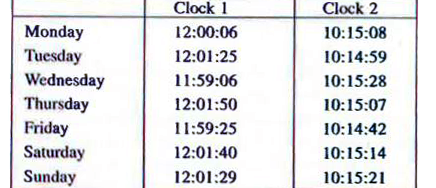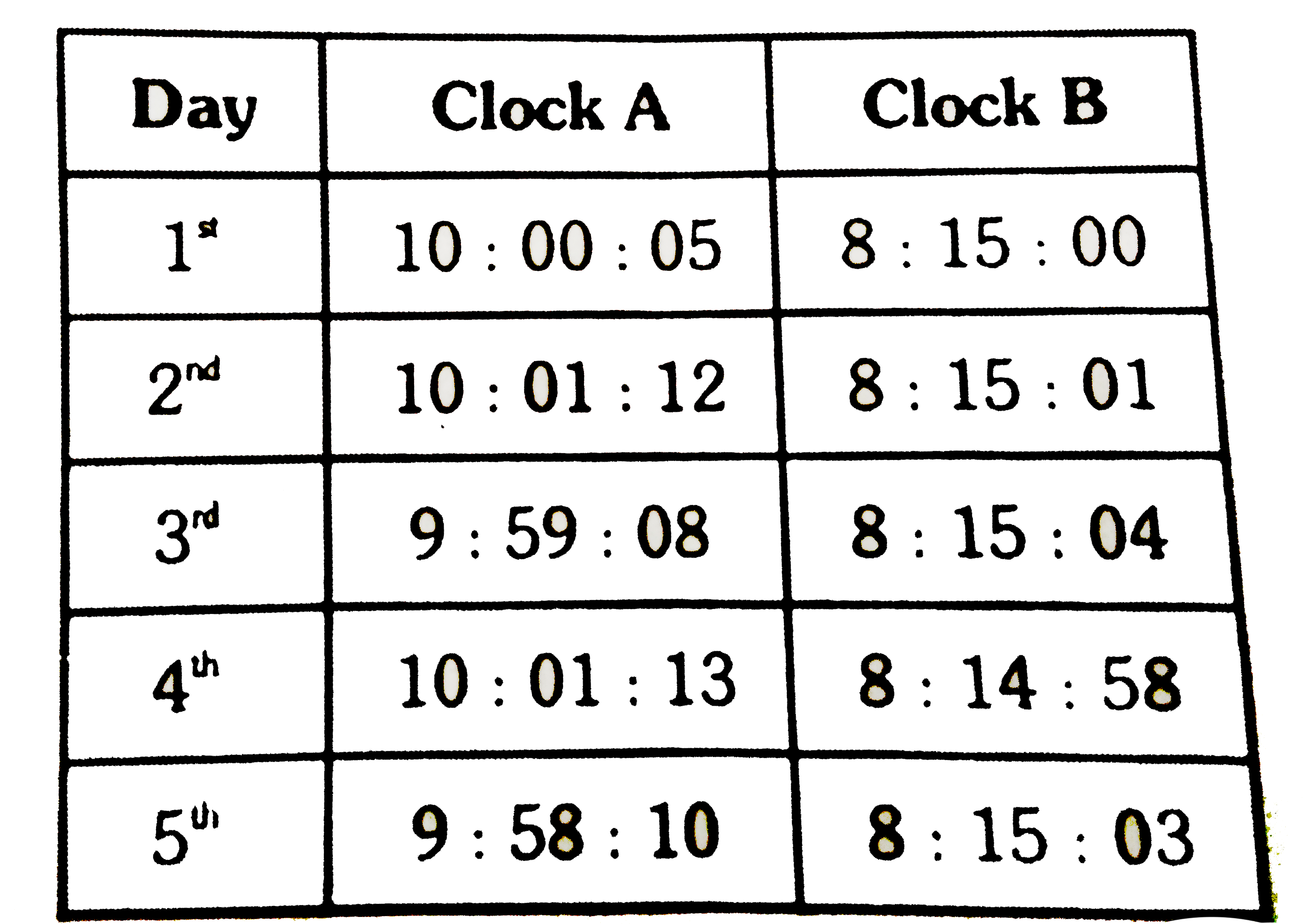Two clocks are being tested against a standard clock located in a national laboratory At 12 : 00 : 00 noon by standard clock, the readins of the two clocks are
DayClock - IClock - IIMonday12:00:0510:15:06Tuesday12:01:1510:14:59Wednesday11:59:0810:15:18Thursday12:01:5010:15:07Thursday12:01:5010:15:07Friday11:59:1510:14:53Saturday12:01:3010:15:24Sunday12:01:1910:15:11
From the Observations carefully read the following conclusive statements.
Statement I : Zero - error in clock II is much longer than zero - error in clock I.
Statement II : Zero - error can always be corrected by applying necessary corrective measures
Statement III : Precision of clock - I is more than precision of clock - II
Statement IV : Precision of clock - II is more than precision of clock - I
Pick up the correction option from the following.
Only I and II are correct
Only I, II, IV are correct
Only, I, II, III are correct
Only I and III are correct
The correct Answer is:B
To solve the problem, we need to analyze the readings of two clocks (Clock I and Clock II) against a standard clock and evaluate the given statements based on the observations. Here’s a step-by-step breakdown of the solution:
Step 1: Understand the Readings
We have the readings of Clock I and Clock II for each day of the week compared to the standard clock at 12:00:00 noon.
- Clock I Readings:
- Monday: 12:00:05
- Tuesday: 12:01:15
- Wednesday: 11:59:08
- Thursday: 12:01:50
- Friday: 11:59:15
- Saturday: 12:01:30
- Sunday: 12:01:19
- Clock II Readings:
- Monday: 10:15:06
- Tuesday: 10:14:59
- Wednesday: 10:15:18
- Thursday: 10:15:07
- Friday: 10:14:53
- Saturday: 10:15:24
- Sunday: 10:15:11
Step 2: Calculate Zero Errors
Zero error is the difference between the standard time (12:00:00) and the clock reading.
- Clock I Zero Errors:
- Monday: 5 seconds (12:00:05 - 12:00:00)
- Tuesday: 75 seconds (12:01:15 - 12:00:00)
- Wednesday: -52 seconds (11:59:08 - 12:00:00)
- Thursday: 110 seconds (12:01:50 - 12:00:00)
- Friday: -45 seconds (11:59:15 - 12:00:00)
- Saturday: 90 seconds (12:01:30 - 12:00:00)
- Sunday: 79 seconds (12:01:19 - 12:00:00)
- Clock II Zero Errors:
- Monday: -6,294 seconds (10:15:06 - 12:00:00)
- Tuesday: -6,301 seconds (10:14:59 - 12:00:00)
- Wednesday: -6,301 seconds (10:15:18 - 12:00:00)
- Thursday: -6,302 seconds (10:15:07 - 12:00:00)
- Friday: -6,307 seconds (10:14:53 - 12:00:00)
- Saturday: -6,296 seconds (10:15:24 - 12:00:00)
- Sunday: -6,299 seconds (10:15:11 - 12:00:00)
Step 3: Analyze Statements
1. Statement I: Zero-error in Clock II is much longer than zero-error in Clock I.
- True: Clock II has a significantly larger negative zero error compared to Clock I.
2. Statement II: Zero-error can always be corrected by applying necessary corrective measures.
- True: Zero error can be corrected by adjusting the clock.
3. Statement III: Precision of Clock I is more than precision of Clock II.
- False: Clock I has varying readings, while Clock II has consistent readings around 10:15.
4. Statement IV: Precision of Clock II is more than precision of Clock I.
- True: Clock II has consistent readings, indicating higher precision.
Step 4: Conclusion
Based on the analysis:
- Correct statements are I, II, and IV.
Final Answer
The correct option is: 1, 2, and 4 are correct.
---
We have the readings of Clock I and Clock II for each day of the week compared to the standard clock at 12:00:00 noon.
- Monday: 12:00:05
- Tuesday: 12:01:15
- Wednesday: 11:59:08
- Thursday: 12:01:50
- Friday: 11:59:15
- Saturday: 12:01:30
- Sunday: 12:01:19
- Monday: 10:15:06
- Tuesday: 10:14:59
- Wednesday: 10:15:18
- Thursday: 10:15:07
- Friday: 10:14:53
- Saturday: 10:15:24
- Sunday: 10:15:11
Zero error is the difference between the standard time (12:00:00) and the clock reading.
- Monday: 5 seconds (12:00:05 - 12:00:00)
- Tuesday: 75 seconds (12:01:15 - 12:00:00)
- Wednesday: -52 seconds (11:59:08 - 12:00:00)
- Thursday: 110 seconds (12:01:50 - 12:00:00)
- Friday: -45 seconds (11:59:15 - 12:00:00)
- Saturday: 90 seconds (12:01:30 - 12:00:00)
- Sunday: 79 seconds (12:01:19 - 12:00:00)
- Monday: -6,294 seconds (10:15:06 - 12:00:00)
- Tuesday: -6,301 seconds (10:14:59 - 12:00:00)
- Wednesday: -6,301 seconds (10:15:18 - 12:00:00)
- Thursday: -6,302 seconds (10:15:07 - 12:00:00)
- Friday: -6,307 seconds (10:14:53 - 12:00:00)
- Saturday: -6,296 seconds (10:15:24 - 12:00:00)
- Sunday: -6,299 seconds (10:15:11 - 12:00:00)
1. Statement I: Zero-error in Clock II is much longer than zero-error in Clock I.
- True: Clock II has a significantly larger negative zero error compared to Clock I.
- True: Zero error can be corrected by adjusting the clock.
- False: Clock I has varying readings, while Clock II has consistent readings around 10:15.
- True: Clock II has consistent readings, indicating higher precision.
Based on the analysis:
- Correct statements are I, II, and IV.
The correct option is: 1, 2, and 4 are correct.
Similar Questions
Two clocks are being tested againest a standard clock located in a national laboratory.
At 12 : 00 : 00 noon by the standard clock, the readings of the two clocks are

Which of the two clocks will you prefer to measure the time intervals during an experiment?View SolutionTwo clocks A and B being tested against a standard clock located in the national laboratory At 10.00 AM by the standard clock, the readings of the two clocks are shown in following table
DayClock AClock BIst10:00:068:15:00IInd10:01:138:15:0.1IIIrd9:59:0.88:15:04IVth10:02:158:14:58Vth9:58:108:15:02
If you are doing an experiment that requires precision time interval measurements, which of the two clocks will you prefer ?View SolutionTwo clocks are being tested against a standard clock located in a national laboratory. At 12:00:00 noon by the standard clock, the readings of the two clocks are :

If you are doing an experiment that requires 'precision time interval' measurements , which of the two clocks will you prefer ?View SolutionTwo clocks are being tsted against a standard clock located in the national laboratory. At 10:00:00 AM by the standard clock, the readings of the clocks are :

If you are doing an experiment that requires prescision time interval measurements, which of the two clock will you prefer ?
(a) Clock A
(b) Clock B
(c) Either Clock A or B
(d) Neithr A nor BView SolutionCalculate the standard deviation from the following following set of observations:
8, 9, 15, 23, 5, 11, 19, 8, 10, 12View SolutionDescribe the following set in set builder form: D={10,11,12,13,14,15}
View SolutionFind the median of the following data 3,5,9,10,11,4,5,8,12,15
View SolutionThe mean deviation about the median of the following distribution is
Marks obtained1011121415Number of students23834View SolutionAt 10 O' clock the hands of a clock make an acute angle and a reflex angle. Find the measure of each of these angles
View SolutionAt 10o' clock, the hands of a clock make an acute angle and a reflex angle. Calculate the size, in degrees, of each of these angles
View Solution

